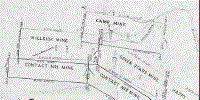
|
(Written by Colonel J.C. Fremont in 1847 (and updated in 1852) about his explorations and observations of California during the Gold Rush.)
The sieve keeps the coarse stones from entering the cradle, the current of water washes off the earthy matter, and the gravel is gradually carried out at the foot of the machine, leaving the gold mixed with a heavy fine black sand above the first cleets. The sand and gold mixed together are then drawn off through auger holes into a pan below, are dried in the sun, and afterwards separated by blowing off the sand. A party of four men thus employed at the lower mines averaged $100 a day. The Indians, and those who have nothing but pans or willow baskets, gradually wash out the earth and separate the gravel by hand, leaving nothing but the gold mixed with sand, which is separated in the manner before described. The gold in the lower mines is in fine bright scales, of which I send several specimens. As we ascended the north branch of the American fork, the country became more broken and mountainous, and at the saw-mill, 25 miles above the lower washings, or 50 miles from Sutter's, the hills rise to about a thousand feet above the level of the Sacramento plain. Here a species of pine occurs which led to the discovery of the gold. Capt Sutter, feeling the great want of lumber, contracted in September last with a Mr. Marshall to build a saw-mill at that place. It was erected in the course of the past winter and spring--a dam and race constructed; but when the water was let on the wheel, the tail-race was found to be too narrow to permit the water to escape with sufficient rapidity. Mr. Marshall, to save labor, let the water directly into the race with a strong current, so as to wash it wider and deeper. He effected his purpose, and a large bed of mud and gravel was carried to the foot of the race. |